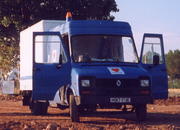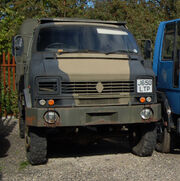 | |
| Manufacturer |
Chrysler Europe Renault Véhicules Industriels |
|---|---|
| Also called | Renault 50 Series |

Renault Dodge 50 "B56" (5600kg) with crew-cab and box body, formerly of British Gas, seen here working for Aid Convoy on a humanitarian project to the former ugoslavia].

4x4 Renault 50 series of the British Army
The Dodge 50 Series, later known as the Renault 50 Series were light commercial vehicles produced in the UK by Chrysler Europe and later Renault Véhicules Industriels (at that time part of Renault, now Volvo Trucks) between 1979 and 1993.
The 50 series included a wide range of chassis and body configurations, including two distinctly different cab designs, and spanned the 3,500–7,500 kg (7,700–17,000 lb) revenue weight range. Various engines were offered, including the Perkins Phaser, and there was a four-wheel-drive version. Bodybuilding companies converted many into various configurations from tipper trucks to buses.
Many were built as "chassis cabs" to have box bodies fitted; these were widely used by utility companies in the UK. They often came fitted with compressors and generators. Gradually this kind of vehicle fell out of favour, partly due to reliability issues relating to combining plant equipment with the vehicle drivetrain. The vehicle is otherwise toughly built. The utility companies today favour smaller vans with towed generators. The four-wheel-drive version saw some use with the British army since it was one of very few British-built trucks of the class, and it could carry considerably more stores and equipment than even the largest Land Rover models.
Chrysler received financial assistance from the British Government which was desperate to support the ailing British motor industry. However, having inherited various struggling car and commercial vehicle marques (and factories) from the Rootes Group, notably the commercial marques Commer and Karrier, in addition to various French concerns, Chrysler Europe struggled to return a profit. In 1978, Chrysler pulled out of their European operations altogether, selling them to Peugeot. The cars and small vans became known as Talbots.
However, Peugeot had little interest in commercial vehicles and the factory for the heavier models was run in partnership with Renault Véhicules Industriels, who sought a UK production site for engines for their existing Renault-branded models. They continued to manufacture the 50 Series, along with the small Dodge Spacevan (formerly Commer Spacevan), and the large Dodge 100 / Commando 2 Series of 7,500–23,000 kg (17,000–51,000 lb) trucks. The transition to Renault branding was slightly muddied by some vehicles bearing both a Dodge name and a Renault-diamond badge.
By 1987, the 50 Series had been updated and was badged solely as the Renault 50 Series; the UK incarnation of the Dodge marque ceased to be used for new vehicles. (Chrysler maintained an entirely separate Dodge brand in the U.S., and in 2006 began re-introducing Dodge car models from the USA into the UK market.) Renault continued to manufacture the 50 Series until 1993, but it was never a great sales success, even being forced to compete with other Renault products, in the form of the Master van, which Renault favoured in its export markets.
In 1994, Renault — keen to clear the factory for large-scale engine production — sold the production tooling to a Chinese manufacturer.[citation (source) needed]
The vehicle is still a common sight on British roads, having become a popular choice for conversion to live-in vehicles (not campers) and workshops. There are also a number still in service as horseboxes, and a few remain in active service with the army. There is a friendly community amongst the owners and users of these vehicles (see external links).
See also[]
| This page uses some content from Wikipedia. The original article was at Dodge 50 Series. The list of authors can be seen in the page history. As with Tractor & Construction Plant Wiki, the text of Wikipedia is available under the Creative Commons by Attribution License and/or GNU Free Documentation License. Please check page history for when the original article was copied to Wikia |
External links[]
- Rootes-Chrysler resource site - page about Spacevan and others
- Specialised Dodge 50 website with manuals, image gallery, forum, and more.
| ||||||||||||||||||||||||||||||